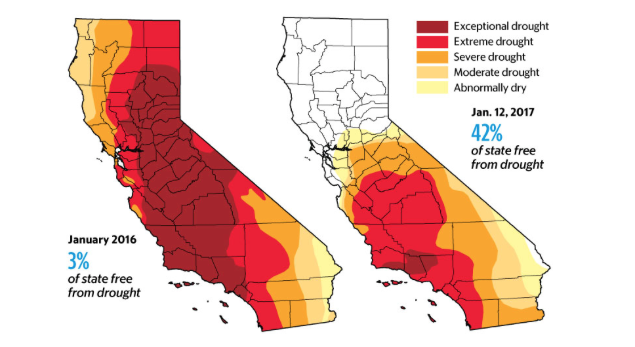Is California’s Drought finally coming to an end?
This map shows the drastic change of California’s drought situation from before and after the rain storm. Lighter areas indicate locations that are more affected by the drought than lighter areas.
January 23, 2017
With the constant rain, the layer of water covering almost all the walkways, and deep puddles of water scattered around campus, one may think California’s drought may finally be coming to an end.
2017 started off with a week of heavy downpour from a rainstorm, falling over multiple areas of California.
According to the U.S. Drought Monitor Map, a map primarily based on precipitation, the San Francisco Bay Area is currently out of the drought, however, areas in Southern California are not.
While different parts of Northern California were able to get a decent or surplus amount of rain, Southern California had been excluded from this benefit.
“We’re getting better in places, but not in others,” Michael Anderson, a climatologist with the California Department of Water Resources said to SF Gate. “We’ve got a mixed bag of conditions going on right now.”
The large storm had not impacted Southern California as it did with Northern California, providing only spotty showers in most locations, like in the Orange counties and Los Angeles.
Back in the San Ramon Valley Unified District, many stayed indoors seeking shelter from the heavy downpour, like sophomore Ashley Lu.
“Everywhere was flooded with water and the rain would not ease up until around nine or ten,” Lu said, “By my home, near Vista Grande, a tree fell down and hit some power lines. Police and fire trucks were there and it was overall a pretty bad situation, but the fact that a sturdy tree fell shows how vicious the storm was.”
The Bay Area had received approximately 7 inches of rain within the first week of the new year, and the number only continued to grow, as the rain storm brewed on.
People have been affected by this storm in many different ways: through blocked roadways, flooding in rivers and lowland areas, and electricity outages.
Various students have been faced with at least one of these interferences caused by the storm, like junior Kimmy Grulla.
“My garage had flood water coming into it so my family and I had to clean it out,” said Grulla, “I had to use lots of towels, and we also created a blockade so the flood water wouldn’t come into my house.”
While the Bay Area experienced a fierce rainstorm, higher elevations experienced an intense snowstorm; some regions received over 40 inches of snow in a matter of two days, like resorts in Lake Tahoe.
Many students from Monte Vista were in Tahoe during the storm, one being freshman Matthew Lee.
“The snowstorm was pretty brutal,” Lee said, “it was about 30 inches of snow per night. The visibility was less than half a mile, but the snowboarding was awesome; everything was powder.”
Although California as a whole isn’t completely out of the drought it’s been stuck in, the recent storm has contributed immensely to counter the drought.
“The storm definitely helped California with the drought,” Lu said, “After the storm, it was reported that Northern California is no longer in a drought, but Southern California still remains in the drought. But by helping half of the state get out of drought, the rain storm was definitely worth it.”












